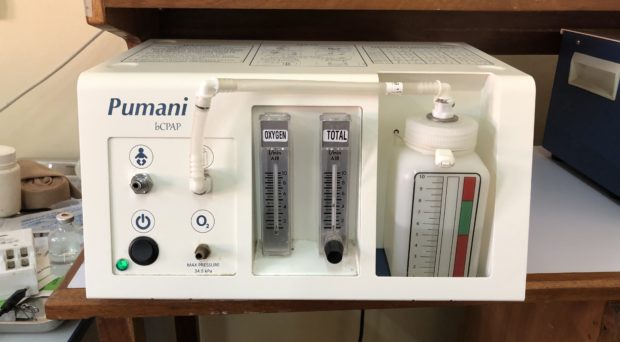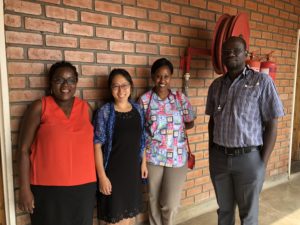
As a part of the Innovations for Maternal and Child Health in Africa (IMCHA) Initiative, funded by the International Development Research Council of Canada, I recently joined up with an inspiring international team researching the barriers and facilitators to implementing lifesaving technologies for newborns in Malawi.
This visit, we are looking into bubble CPAP (continuous positive airway pressure), which supports breathing in babies with respiratory distress. There is evidence that this saves lives and it has been recommended by WHO. However, what is not clear is how it fares in resource-constrained settings such as in many Sub-Saharan African hospitals.
I had the privilege to go to the Chatinkha Nursery in Queen Elizabeth Central Hospital, the largest Malawi, where bubble CPAP was pioneered in the nation. Malawi has staggeringly high rates of preterm birth with 18.1 preterm births per 100 live births, which are the highest in the world. More than 50% of babies born at 31 weeks gestation or earlier will develop respiratory distress syndrome, which often develops alongside serious infections, namely neonatal pneumonia and neonatal sepsis.
Babies with respiratory distress syndrome can be effectively managed with mechanical ventilation or CPAP machines; however, hospitals in resource-constrained settings face significant challenges. Mechanical ventilation and CPAP machines can be very expensive. Even a typical bubble CPAP set up costs upwards of $6000 and may be technically complex to train and maintain.
Hospitals in resource settings have become innovative, making homemade creations out of tubing and water bottles. A low cost version was also developed and tested here in the Chatinkha Nursery. If you imagine blowing up a balloon, the hardest part is getting started. The same is for alveoli, the air sacs in the lungs. For its amazing capacity to save newborn lives, bubble CPAP is based on a remarkably simple concept of safely regulating air pressure by submerging an end of the tubing into water. The depth of the tube in the water determines the pressure in the system, which keeps a bit of air left in the lungs to support the baby’s breathing. This is called functional residual lung capacity.

Visiting Chatinkha Nursery
The College of Medicine is located beside Queen Elizabeth Central Hospital, as many of the professors and lecturers are also clinicians. Together with the IMCHA Malawi project coordinator, we walk over to the hospital grounds. The busy traffic of Ginnery Corner, full of pedestrians and people selling snacks on the sidewalk, is contrasted with quiet grounds inside the hospital compound walls.
We walk through a narrow gate and are welcomed into the sprawling grounds. Resilient patches of grasses sprout from the otherwise dusty dirt but there are many trees from lush green mango trees to stunning jacaranda trees currently blooming with bright violet flowers. Family members of people in the hospital lounge in the shade. Without the project coordinator, I would be lost in the maze of wards. He leads us to the delivery area where there is a quiet hush within its painted concrete hallways.
There are rows of benches beside the windows looking into the Chatinkha Nursery, where the nurse in charge of the ward welcomes us in. The warm, humid air blankets us and the ward is quiet except for the murmurs of student doctors checking up on their tiny patients and the whirl and occasional blip of the machines.
The Chatinkha Nursery is a special neonatal intensive care unit close to the delivery ward, the nurse in charge informs us. When a baby is born or referred from another hospital and requires immediate care, they are brought to this ward.
“The nurse in charge of the ward said that she has been here for five years and on average, there are about two babies a day on the bubble CPAP machines.”
We walk over to a baby currently on bubble CPAP. A tube is connected to a portable oxygen concentrator, which collects oxygen from the air and sends it to the Pumani bubble CPAP machine. In the bubble CPAP machine, there are two measures, one showing the liters of oxygen per minute and the other of blended air. Then, there is a container of water with 6-8 centimeters clearly marked in green as the typical depth for pressure and levels outside marked in red. The water is bubbling away. While the small newborn’s eyes are closed, we could see the chest inflate and deflate slightly with each breath.
The nurse in charge of the ward said that she has been here for five years and on average, there are about two babies a day on the bubble CPAP machines. In front of each of the babies is a bench where mothers can sit while they visit and care for their newborns. Beside us while we were talking was a mother breastfeeding her infant. Because the Chatinkha is an intensive care unit, mothers and other guardians are only allowed access to the ward every couple of hours. As we said our thanks and good byes to the nurse, a number of women had gathered in the waiting area, eagerly looking in through the glass windows and waiting to go in.
As I continue working on the research with the amazing team here at the College of Medicine, I bring this experience of visiting the nursery with me. Not just numbers or words on a page, these innovations have critical impact on some of the newest members of humanity.
Comments